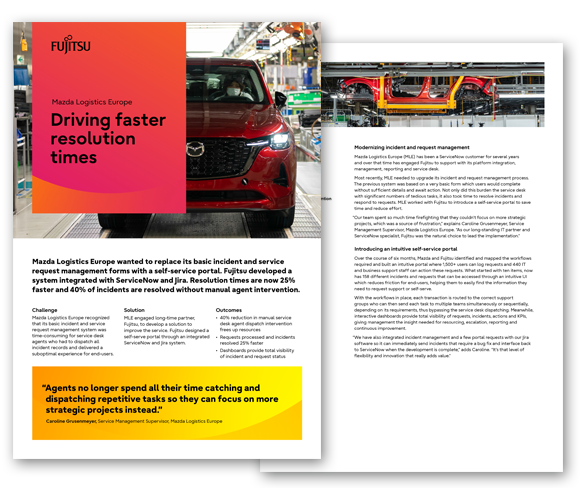Mazda Logistics Europe wanted to replace its basic incident and service request management forms with a self-service portal. Fujitsu developed a system integrated with ServiceNow and Jira. Resolution times are now 25% faster and 40% of incidents are resolved without manual agent intervention.
Challenges
Mazda Logistics Europe recognized that its basic incident and service request management system was time-consuming for service desk agents who had to dispatch all incident records and delivered a suboptimal experience for end-users.
Solutions
MLE engaged long-time partner, Fujitsu, to develop a solution to improve the service. Fujitsu designed a self-serve portal through an integrated ServiceNow and Jira system.
Outcomes
- 40% reduction in manual service desk agent dispatch intervention frees up resources
- Requests processed and incidents resolved 25% faster
- Dashboards provide total visibility of incident and request status
Agents no longer spend all their time catching and dispatching repetitive tasks so they can focus on more strategic projects instead.
Caroline Grusenmeyer, Service Management Supervisor, Mazda Logistics Europe

40%
reduction in manual service desk intervention
25%
faster resolution times
- Industry: Automotive
- Location: Belgium
- Customer's website

About the customer
Mazda Motor Logistics Europe (MLE) is responsible for distributing cars and parts to European customers as quickly and efficiently as possible. MLE was founded in 1968 and is located in Willebroek, Belgium. On top of its logistics activities, MLE offers financial and IT services to all Mazda Central and National Sales Companies
Modernizing incident and request management
Mazda Logistics Europe (MLE) has been a ServiceNow customer for several years
and over that time has engaged Fujitsu to support with its platform integration,
management, reporting and service desk.
Most recently, MLE needed to upgrade its incident and request management process.
The previous system was based on a very basic form which users would complete
without sufficient details and await action. Not only did this burden the service desk
with significant numbers of tedious tasks, it also took time to resolve incidents and
respond to requests. MLE worked with Fujitsu to introduce a self-service portal to save
time and reduce effort.
“Our team spent so much time firefighting that they couldn’t focus on more strategic
projects, which was a source of frustration,” explains Caroline Grusenmeyer, Service
Management Supervisor, Mazda Logistics Europe. “As our long-standing IT partner and
ServiceNow specialist, Fujitsu was the natural choice to lead the implementation."
Introducing an intuitive self-service portal
Over the course of six months, Mazda and Fujitsu identified and mapped the workflows
required and built an intuitive portal where 1,500+ users can log requests and 440 IT
and business support staff can action these requests. What started with ten items, now
has 158 different incidents and requests that can be accessed through an intuitive UI
which reduces friction for end-users, helping them to easily find the information they
need to request support or self-serve.
With the workflows in place, each transaction is routed to the correct support
groups who can then send each task to multiple teams simultaneously or sequentially,
depending on its requirements, thus bypassing the service desk dispatching. Meanwhile,
interactive dashboards provide total visibility of requests, incidents, actions and KPIs,
giving management the insight needed for resourcing, escalation, reporting and
continuous improvement.
“We have also integrated incident management and a few portal requests with our Jira
software so it can immediately send incidents that require a bug fix and interface back
to ServiceNow when the development is complete,” adds Caroline. “It’s that level of
flexibility and innovation that really adds value."
Faster resolution, less manual intervention
Now, 40 percent of requests and incidents are automatically dispatched through
the portal catalog. Naturally, that frees up 40 percent of the service desk resources,
which are now free to focus on strategic projects, making their roles more fulfilling.
The most popular requests include support for marketing campaigns, onboarding
new users and Mazda portal access.
At the same time, the dashboard enables management to track and trace incidents,
and close of f requests more quickly – incidents are resolved 25 percent faster.
As there are fewer tickets bouncing between teams thanks to workflows ensuring
they immediately reach the right team, there are further significant efficiency gains.
“Now users can easily find what they need themselves in the service catalog and
can track their requests. It makes us all more productive,” concludes Caroline.








